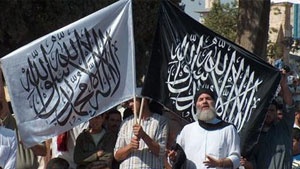Summary of the Position
On Saturday 2 July 2011, members of Hizb al‐Tahrir gathered in several towns of the West Bank to hold peaceful marches commemorating the 90th anniversary of the fall of the Islamic Caliphate as constituted by the Ottoman Empire.1 Al‐Haq documented the planning phase for the commemorative marches and their dispersal by Palestinian Security Forces. Despite having submitted a written announcement of the march in Ramallah, Palestinian Security Forces violently dispersed it along with several other marches in a number of West Bank towns.2
The dispersal of the 2 July Hizb al‐Tahrir marches constitutes a violation of the Palestinian Basic Law, Law 12 of 1998 Concerning Popular Assembly, and Law 15 of 1955 Concerning Political Parties. The Palestinian Authority (PA) committed similar iolations while dispersing Hizb al‐Tahrir marches in the past3 as well as other types of peaceful assemblies in the West Bank.4 Al‐Haq calls for an investigation to determine responsibility for these violations in order to enforce accountability. Al‐Haq also calls on the PA tocomply with the law and respect the rights of Palestiniansenshrined therein.
AL-Haq Documentation
The Hizb al‐Tahrir spokesperson for the West Bank, Baher Saleh, informed one of Al‐Haq’s field researchers that the party began preparations for the commemorative event by submitting a written notification , as required under Palestinian law, of the 2 July march in Ramallah to the Ramallah Governorate’s Office on 8 June 2011. Hizb al‐Tahrir reportedly has a picture of this written notification and also reported to have received confirmation of the notification’s receipt by the Governorate’s Office.
Hizb al‐Tahrir undertook preparations for the march during the month of June. On 30 June, Saleh was summoned to the Deputy Governorate’s Office in Ramallah where he was verbally informed of the PA’s final decision that Hizb al‐Tahrir would not be allowed to hold the march.
A member of the Hizb al‐Tahrir Media Office, ‘Ala’ Abu Saleh,notedthat the PA justified its decision by the fact that Hizb al‐Tahrir is not a licensed party and therefore cannot exercise the right to peaceful assembly. Hizb al‐Tahrir planned
marches in other West Bank towns in response to the negative decision. On 2 July, the Palestinian Security Forces employed violent techniques to disperse the protestors. Al‐Haq gathered the following information on what happened that day:
Nablus:
The Palestinian forces attacked protestors at around 5:00 pm approximately 150 metres from the al‐Salahi Mosque. Two security personnel drew pistols and fired in the air, creating chaos on the street. They then shot live bullets at the ground near the feet of the protestors, wounding six people with shrapnel.
Qalqiliya:
At around 5:00 pm, Palestinian forces beat protestors with batons to disperse the march, resulting in the injury of several individuals. One man was beaten while documenting the violence with his mobile phone.
Hebron:
The march left al‐Sheikh ‘Ali al‐Baka’ Mosque in the direction of Bab al‐Zawiyya at around 5:00 pm. Palestinian forces fired tear gas canisters and hit protestors with batons. About 20 people were injured.
Other Protests:
The Hizb al‐Tahrir protests in Kufr ‘Aqab, Salfit, Toulkarem, Ramallah, and Bidiya resulted in dozens wounded and arrested by Palestinian forces.
The Marches in a Legal Context
The PA prevented Hizb al‐Tahrir from holding their primary protest in Ramallah firstby verbally denying Hizb al‐Tahrir permission to gather on 2 July and then by force during the march itself. Al‐Haq addresses the illegality of the PA’s decisions and actions under Palestinian law in the following legal analysis:
Law 15 Concerning Political Parties of 1955:
The PA denied Hizb al‐Tahrir permission to peacefully assemble on 2 July 2011 on the basis that the party is not
licensed. This argumentcontravenes Article 12 of Law 15 Concerning Political Parties of 1955, which states that “[a]ll political parties that were operating when this law came into force stand and may continue in their party activities, according to this law.”5Hizb al‐Tahrir was founded in Jerusalem in 1953 by the judge Taqi al‐Din al‐Nabhani and participated in the parliamentary elections of the West Bank in 1955. It is therefore a standing party entitled to the rights outlined by Law 15, which holds force in theWest Bank to this day.
Law 12 Concerning Peaceful Assembly of 1998:
The Ramallah Governorate’s 30 June verbal refusal to allow Hizb al‐Tahrir to peacefully gather on 2 July did not comply with the provisions of Law 12 Concerning Peaceful Assembly of 1998, which proscribes for the response to be in writing. Article 4 of that law provides that in the absence of a written response to the organising party’s announcement of the intention to peacefully assemble, the organising party has tacit permission to conduct its gathering as outlined in its initial written notification. Because Hizb al‐Tahrir did not receive a written response from the Governorate, the party was legally permitted to hold their march without any negotiations on time, location, or other logistics of the gathering.
The Palestinian Basic Law (Article 26):
Article 26 of the Palestinian Basic Law guarantees the right to peacefully assemble, which is further emphasised by Article 2 of Law 12 Concerning Peaceful Assembly. Article 26 of the Basic Law states that “Palestinians shall have the right to participate in political life, both individually and collectively, and have the following rights in particular: […] To conduct public meetings, processions, and assemblies within the limits of the law.”6 Article 2 of Law 12 Concerning Peaceful Assembly confirms this constitutional right.
The Palestinian Basic Law (Article 84):
Article 84 of the Palestinian Basic Law emphasises that security and police force may only be used within the limits outlined by respect for rights and freedoms. Excessive use of force such as firing live ammunition on peaceful protesters in Nablus also breaches the Code of Conduct for Law Enforcement Officials adopted by the UN General Assembly in 1979 and the Basic Principles on the Use of Force and Firearms by Law Enforcement Officials of 1990 that detail the standard of the use of force in international human rights law, and form part of customary international law that binds law enforcement officials.
The Palestinian Basic Law (Article 32):
The use of excessive force in denying Hizb al‐Tahrir the right to peacefully assemble is considered a crime under Article 32 of the Palestinian Basic Law, which calls for the perpetrators to be held accountable and demands fair compensation for victims.
Download summary in PDF format
- Hizb al‐Tahrir [Liberation Party] is an international political organisation founded in the West Bank in 1953. It calls for the establishment of a worldwide Islamic Caliphate.
- Bidiya, Hebron, Kufr ‘Aqab, Nablus, Qalqiliya, Ramallah, Salfit, Toulkarem.
- On 17 July 2010, Palestinian Security Forces dispersed Hizb al‐Tahrir commemorative marches (Z. Hamidan ‘The Palestinian Division as a Black Page in Rights and Freedoms’ Al‐Haq, June 2011.)
- On 27 November 2007, two peaceful protests in Ramallah and Hebron set out supporting the Palestinian cause at the Annapolis Conference. Palestinian Security Forces attacked the protestors, shooting and killing Hisham Na’im Yousef al‐Beradei in Hebron (Z. Hamidan ‘The Palestinian Division as a Black Page in Rights and Freedoms’ Al‐Haq, June 2011.)
-
Law 15 Concerning Political Parties of 1955. Unofficially translated from the Arabic by Max
Budovitch. -
Article 26, Palestinian Basic Law. Unofficially translated from the Arabic by Max Budovitch in
consultation with The Palestinian Basic Law, ‘2002 Basic Law’ <http://www.palestinianbasiclaw.org/2002‐basic‐law> accessed 3 August 2011.



 Al-Haq Position Paper: Palestinian Authority Violations of the Right to Peaceful Assembly: The repeated denial of Hizb al-Tahrir’s right to peaceful assembly in the West Bank.
Al-Haq Position Paper: Palestinian Authority Violations of the Right to Peaceful Assembly: The repeated denial of Hizb al-Tahrir’s right to peaceful assembly in the West Bank.